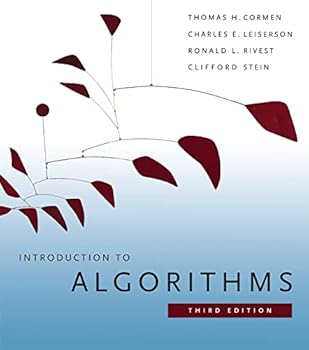Introduction to Algorithms, 3rd Edition (Mit Press)
Select Format
Select Condition 
Book Overview
Some books on algorithms are rigorous but incomplete; others cover masses of material but lack rigor. Introduction to Algorithms uniquely combines rigor and comprehensiveness. The book covers a broad... This description may be from another edition of this product.
Format:Hardcover
Language:English
ISBN:0262033844
ISBN13:9780262033848
Release Date:September 2009
Publisher:MIT Press
Length:1292 Pages
Weight:5.05 lbs.
Dimensions:2.1" x 8.2" x 9.1"
Customer Reviews
3 ratings
The New Edition is Great!
Published by Thriftbooks.com User , 23 years ago
For years, I've looked for a single algorithms book that would cover all of the bases and provide an up-to-date replacement for the 3 Knuth volumes. The 2001 edition of CLR is it. I had looked at earlier versions of CLR and somehow not seen what I wanted; seemed too much like a enumeration of algorithms rather an explanation of them. But what the other reviewers say about CLR is definitely true of this edition. Its the one you want on your shelf to accompany your career in software or computer science.The reviewers who knocked off stars for being difficult were probably also correct; this book is not for community college course with students who earned Cs in math and programming courses. In fact, I question the word "introduction" in the title. Yes, it only assumes minimal math and programming knowledge, but it goes a long ways into the topic. Sure, it might not cover some exotic academic topics or some very specialized topics, but if you are a software engineer it has all you are likely to want or need in your practical work (until there are new research results that prove important in industry) unless you work in area that requires specialized algorithms.One topic regretablly omitted from this book, and most other books on algorithms, is extendible hashing, hashing techniques that support an arbitrary, unkown amount of data. Papers by Fagin and Litwin describe such methods.
What every computer scientist should have
Published by Thriftbooks.com User , 24 years ago
If one were to make a list of the 100 best books in computer science, then winnow that list down to 10 books, and then again down to 1 book, surely this would be that book.Known in computer science circles as CLR (for the authors) or simply, "The White Book", Introduction to Algorithms by Cormen, Leiserson, and Rivest is the de-facto standard text for algorithms and data structures. It covers all the basic subjects (big-O notation, trees, graphs, etc...) as well as a few intermediate subjects (amortized analysis, matroids, etc...). Of course, this book is not the be-all and end-all of computer science nor does it pretend to be. It touches on NP-completeness only lightly and all but omits randomization; but if you wanted a text on NP-completeness, you would be reading Garey & Johnson and if you wanted randomization you'd go to Motwani & Raghavan. But if you need a reference on data structures and algorithms, this is the book for you.Now, some have complained that while this book is an excellent reference that it is a poor text to learn from. I beg to differ. I concede that it is certainly more demanding than many other introductory texts, but this is a boon not a curse. By remaining true to computer science's mathematical heritage, Cormen et al. force the reader to become accustomed to rigourous, formal reasoning, something which is unfortunately absent in many computer science curricula. The authors present the concepts cleanly and clearly, without the distraction of any specific programming language/paradigm. Perhaps it is this removal from a familiar C/C++/Java/flavour-of-the-month/etc... milieu which makes some readers nervous. But it is precisely this separation which forces the reader up into the realm of abstraction where computer science truly resides.
Rigorous coverage of the most widely used algorithms
Published by Thriftbooks.com User , 25 years ago
I personally bought this book in preparation for the International Olympiad in Informatics (IOI), and it helped me immensely in getting off the ground with the algorithms I had to learn, especially the chapter on Dynamic Programming. Since then, however it has remained a priceless companion during my studies and at home.This is the definitive reference for algorithms with a firm theoretical and mathematical foundation. Algorithms are treated with a thorough theoretical introduction often with a complete mathematical walkthrough, a clearly thought out solution, a discussion of its pros and cons, lots of clear and consisive diagrams, a pseudocode implementation, and a good deal of serious optimisation discussion. It's written in an accessible manner, starting with the elementary issues, progressing to the advanced and complex thinking needed to conquer them, so you'll find you have to give it your full concentration.This book will not disappoint. Its explanations are rigorous and its coverage spans all the general purpose algorithms with little focus on their applications but rather on the algorithms themselves. The book covers such major areas as sorting, data structures, advanced design and analysis techniques, graphs, each about a hundred pages on average, and a selection of specialised algorithms such as parallel programming, string matching and computational geometry. Because these algorithms are used everywhere, from games, graphics and simulations to electrical engineering it will have a broad audience and will find a home almost anywhere there is serious programming involved. Each chapter is a unit in itself which means you don't need to read it cover to cover, since they all start off smoothly and handhold you through. Clearly written by professionals, this is the book I know contains the information that I can't find elsewhere.







